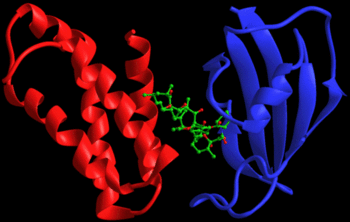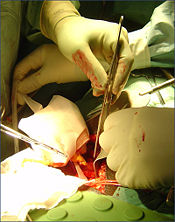It07:Rapamycin
| Rapamycin | ||||
|---|---|---|---|---|

| ||||
| General | ||||
| Systematic name | (3S,6R,7E,9R,10R,12R,14S,15E,17E,19E,21S,23S, 26R,27R,34aS)-9,10,12,13,14,21,22,23,24,25,26, | |||
| Other names | Sirolimus, Antibiotic AY 22989, Rapamune, RAPA, RPM | |||
| Molecular formula | C51H79NO13 | |||
| SMILES | CC1CCC2CC(C(=CC=CC=CC(C C(C(=O)C(C(C(=CC(C(=O) CC(OC(=O)C3CCCCN3C(= O)C(=O)C1(O2)O)C(C) | |||
| CAS number | 53123-88-9 | |||
| Merck Index | 12, 8288 | |||
| Properties | ||||
| Molar mass | 914.17 g/mol | |||
| Melting point | 183°C-185°C (456K-458K) | |||
| Boiling point | ?°C (? K) | |||
| Optical Rotary Power (ORP) | -58.2° at 589nm and 25°C | |||
| Solubility | Soluble in Methanol, DMSO (Dimethyl sulfoxide) | |||
| Appearance | White/Yellow powder | |||
| Safety | Harmful if swallowed | |||
| Except where noted otherwise, data are given for materials in their standard state (at 25 °C, 100 kPa) Infobox disclaimer and references | ||||
Overview
Also known as Sirolimus, Rapamycin is used in combination with other medications to prevent rejection of kidney transplants. In a class of medications called immunosuppressants, it works by suppressing the body's immune system. More specifically, it inhibits cytokine production by disrupting the transcriptional activation of cytokines. Rapamycin is a triene macrolide antibiotic, which demonstrates anti-fungal, anti-inflammatory, anti-tumor, anti-neoplastic and immunosuppressive properties. It has been shown to block T-cell activation and proliferation, as well as the activation of p70 S6 kinase, and exhibits strong binding to FK-506 binding proteins. Rapamycin also inhibits the activity of the protein mTOR, (mammalian target of rapamycin) which functions in a signalling pathway to promote tumor growth: it binds to a receptor protein (FKBP12) and the Rapamycin/FKB12 complex then binds to mTOR, preventing interaction of mTOR with target proteins in this signalling pathway. However, Rapamycin will only do this if it is bound to immunophilins. Rapamycin’s name is derived from the native word for Easter Island, Rapi Nui.
The above shows how Rapamycin blocks T-cell activation by inserting itself between two proteins in the body.
Uses
Rapamycin's main use is currently to help prevent rejection of organ transplants by suppressing the body's immune system. It is also in testing stages as a treatment for cancer. Rapamycin potently inhibits downstream signalling from the mammalian target of Rapamycin (mTOR) proteins which functions in a signalling pathway to promote tumor growth. These evolutionarily conserved protein kinases coordinate the balance between protein synthesis and protein degradation in response to nutrient quality and quantity.
Alternative Treatments
The most commonly used immunosuppressives are currently Cyclosporin and FK506. Both of these work in a different way to Rapamycin by inhibitng calcineurin in the T-cells. Although it works in a very different way, FK506 binds to FKBP in exactly the same way Rapamycin does and shows strucural similarities to it.
The main disadvantages of alternative drugs are that they must be taken for the rest of the patient's life and do not guarantee long-term survival of the organ; 55% of transplanted kidneys fail within ten years. Because of the suppression of the entire immune system, they also make patients susceptible to viruses, bacteria and cancer.
References
1. http://www.nlm.nih.gov/medlineplus/druginfo/medmaster/a602026.html
2. http://www.agscientific.com/Item/R1018.htm
3. http://www.thompsonsurgical.com/surgical_specialties/transplant/index.htm
4. http://www.fermentek.co.il/rapamycin.htm
5. Journal; Seghal et al.; JANTAJ; J. Antibiot.; 28; 1975; 727,729.
6. http://www.proteinkinase.biz/Shop/page.php?modul=GoShopping&op=show_article&aid=361&cid=74
7. http://www.ch.ic.ac.uk/local/projects/russell/index.html


